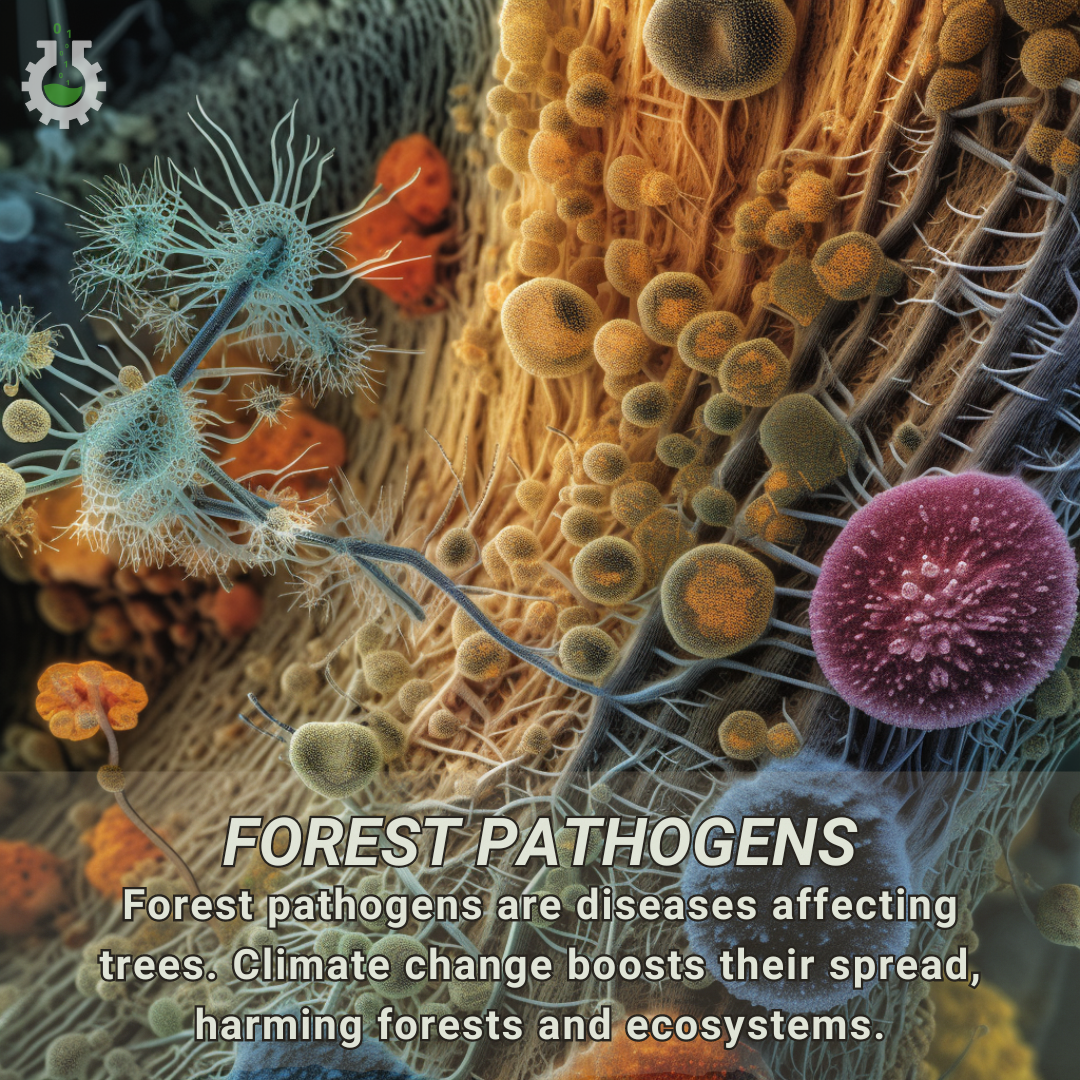July 8, 2024
Climate Change Poster Collection of the Day – Forest Pathogens
Book a Demo
Today’s Climate Change Poster Collection highlights Forest Pathogens. Forest pathogens are microscopic agents, including fungi, bacteria, and viruses, that cause diseases in trees and other forest plants. These pathogens have always been a part of forest ecosystems, playing roles in natural cycles of growth and decay. However, their impact can be devastating when they infect trees, leading to symptoms such as leaf spots, cankers, wilting, and even tree death. Some well-known forest pathogens include the fungi responsible for Dutch elm disease and chestnut blight, as well as the bacteria causing fire blight. While these pathogens can be naturally occurring, their effects are significantly amplified by environmental changes, making them a growing concern in the context of climate change.
Climate change is an omnipresent force reshaping ecosystems worldwide, and one of its insidious impacts is the proliferation of these forest pathogens. Rising temperatures, altered precipitation patterns, and increased frequency of extreme weather events create a perfect storm for these pathogens to thrive. Warmer temperatures can extend the growing season for fungi and insects that carry diseases, while milder winters fail to kill off overwintering pests. Additionally, drought-stressed trees become more susceptible to infections, as their weakened state diminishes their natural defenses. For instance, the bark beetle, which carries a deadly fungus, has decimated millions of acres of pine forests in North America, a phenomenon exacerbated by warmer winters and prolonged droughts. This beetle infestation has turned once-thriving forests into vast stretches of dead and dying trees, creating tinderboxes that fuel devastating wildfires. Similarly, the sudden oak death, caused by the pathogen Phytophthora ramorum, has spread more rapidly due to wetter and warmer conditions, leading to significant losses in oak populations across the United States and Europe.
These pathogens not only threaten biodiversity by killing off large swathes of trees but also disrupt the carbon sequestration capabilities of forests, further accelerating climate change in a vicious cycle. Forests act as carbon sinks, absorbing CO2 from the atmosphere and storing it in biomass and soil. When trees die and decompose or burn in wildfires, the stored carbon is released back into the atmosphere, contributing to greenhouse gas concentrations. The loss of trees affects entire ecosystems, from the soil microorganisms that rely on tree roots to the animals that depend on forest habitats. Birds, mammals, and insects that depend on specific tree species for food and shelter find their habitats shrinking, leading to declines in their populations. This cascading effect can result in the loss of entire ecosystems, disrupting the delicate balance of nature.
Efforts to combat these pathogens are increasingly challenging, as traditional methods like chemical treatments and controlled burns may not be effective against the backdrop of a rapidly changing climate. For example, fungicides and pesticides may become less effective as pathogens evolve resistance, and the altered climate conditions can render some control methods impractical or even harmful to non-target species. Additionally, the movement of pathogens across borders due to global trade and travel complicates efforts to contain outbreaks. Therefore, understanding the intricate relationship between forest pathogens and climate change is crucial for developing adaptive management strategies that can mitigate these impacts and preserve the health and biodiversity of our forests.
Innovative approaches such as breeding disease-resistant tree species, employing biological control agents, and enhancing forest resilience through diverse plantings are being explored. However, these solutions require significant investment in research and collaboration among scientists, policymakers, and forest managers. Public awareness and education about the importance of forest health and the threats posed by climate change are also vital for garnering support for conservation efforts. The urgency to address these issues cannot be overstated, as forests play a pivotal role in regulating the Earth’s climate, supporting wildlife, and providing resources for human livelihoods. Protecting our forests from pathogens in the face of climate change is not just an environmental imperative but a necessity for the well-being of future generations.
The connection between forest pathogens and climate change is a complex and multifaceted issue that demands immediate attention and action. As climate change continues to alter the conditions under which forests thrive, the spread and impact of pathogens are likely to intensify. By understanding these dynamics and implementing adaptive strategies, we can work towards safeguarding our forests and the myriad of benefits they provide. The health of our planet’s forests is intrinsically linked to the health of our global ecosystem, and addressing the challenges posed by forest pathogens in a changing climate is a critical step in ensuring a sustainable future for all.
Discover an inspiring collection of climate change poster.



